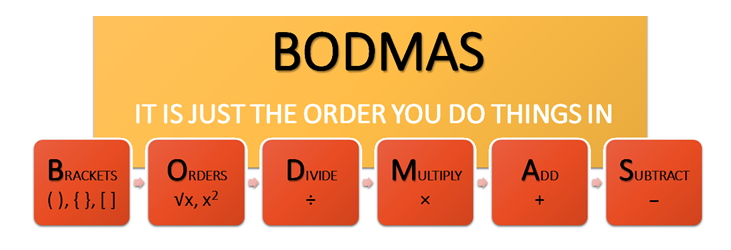Formulas
What is BODMAS Rule ?
BODMAS rule defines the correct sequence in which operations are to be performed in a given mathematical expression to find its value.
In BODMAS,
B = Bracket
O = Order (Powers, Square Roots, etc.)
DM = Division and Multiplication (left-to-right)
AS = Addition and Subtraction (left-to-right)
In some countries, the acronym PEMDAS is used instead of BODMAS. PEMDAS stands for “Parentheses, Exponents, Multiplication, Division, Addition, and Subtraction”.
Order of Operations :
- While simplifying an expression, the following order must be followed.
- Do operations in brackets first, strictly in the order (), {} and []
- Evaluate exponents (powers, roots, etc.)
- Perform division and multiplication, working from left to right. (division and multiplication rank equally and done left to right).
- Perform addition and subtraction, working from left to right. (addition and subtraction rank equally and done left to right).
Virnaculum (or Bar):
When an expression contains Virnaculum, before applying the ‘BODMAS’ rule, we simplify the expression under the Virnaculum.
In VBODMAS, V : Virnaculum or bar B : Bracket O : Of or Order D : Division M : Multiplication A : Addition S : Subtraction
Modulus Modulus of a real number x is its positive value, denoted by |x|. Thus, |7| = 7 and |−7| = 7
Formulas :
- $(a + b)^{2} = a^{2} + b^{2} + 2ab$
- $(a – b)^{2} = a^{2} + b^{2} – 2ab$
- $(a + b) (a – b) = a^{2} – b^{2}$
- $(a + b)^{2} – (a – b)^{2} = 4ab$
- $(a + b)^{2} + (a – b)^{2} = 2(a2 + b2)$
- $(a + b + c)^{2} = a^{2} + b^{2} + c^{2} + 2(ab + bc + ac)$
- $(a^{3} + b^{3}) = (a + b)(a^{2} – ab + b^{2})$
- $(a^{3} – b^{3}) = (a – b)(a^{2} + ab + b^{2})$
- $(a + b)^{3} = a^{3} + b^{3} + 3ab(a + b)$
- $(a – b)^{3} = a^{3} – b^{3} – 3ab(a – b)$
- $(a^{3} + b^{3} + c^{3} – 3abc) = (a + b + c) (a^{2} + b^{2} + c^{2} – (ab + bc + ca)$
- If a + b + c = 0, then $a^{3} + b^{3} +c^{3} = 3abc$
BODMAS Rule
Basically, BODMAS rule tells us what order to do arithmetic operations like addition, subtraction, division, squaring etc. in a problem. This means that to simplify an expression, the following order must be followed.
What is the right order of operations?

Addition and Subtraction:
Example:
60 + 5 * 12 - 20=?
By using BODMAS rule,
Step 1:First we have to solve the multiplication,so 5 * 12=60.
Step 2:Then,Do addition and subtractions
60 + 60=120
Step 3:Subtract 20 from 120.
Therefore,120-20=100.
Multiplication and Division:
Multiplication:
Example:
Multiply the number 79 by 99
Step 1) Multiply the number by 100 = 7900
Step 2)Subtract original number from 7900 ie 7900 - 79 = 7821
So the answer is 7821.
Divisibility Rules:
Divisibility by 2:
Rule:If the number ends with 0,2,4,6,8 then it’ll be divisible by 2
Example:
Is 92 Divisible by 2?
Yes, the number 92 ends with 2 therefore it must be divisible by 2
Exercise:
Divisibility by 3:
Rule:Sum of the given digits will be divisible by 3
Example:
Divide 549 by 3.
Step 1)Sum of the digits=5+4+9=18
Step2)18 is divisible by 3 and hence 549 is also divisible by 3
Exercise :
Divisibility by 4:
Rule:Last two digits of the given number should be divisible by 4
Example:
Divide 5648 by 4.
Step 1)Last two digits are 4 and 8 i.e.48
Step2)48 is divisible by 4 and hence 5648 is also divisible by 4
Exercise :
Divisibility by 5:
Rule: If the number ends with 0 or 5 then it’ll be divisible by 5.
Example:
Divide 12345 by 5.
Step 1)the given number is ends with 5
Step2)therefore 12345 is divisible by 5
Exercise :
Divisibility by 6:
Rule: If the given number is divisible by 2 & 3 then it will be divisible by 6.
Example:
Divide 4536 by 6
Step 1)The last digit of the given number is 6.so it is divisible by 2.
Step2)Sum of its digit 4+5+3+6 =18 which is divisible by 3.Hence it is divisible by 6.
Exercise :
Divisibility by 8:
Rule: If the last three digits in the given number is divisible by 8 then the number be divisible by 8
Example:
Divide 746848 by 8.
Step 1) Here the last three digits are 848 which is divisible by 8
Step2) Hence the given number is also divisible by 8.
Exercise :
Divisibility by 10:
Rule: If the last digit in the given number ends with 0 then the number will be divisible by 10.
Exercise :
Divisibility by 11:
Rule:[Sum of its digits in odd places-Sum of its digits in even places]=0 or divisible by 11.
Example:
Divide 39798847 by 11.
Step 1) [(7+8+9+9)-(4+8+7+3)]
Step2) (23-12)=11,which is divisible by 11.So 39798847 is divisibility by 11.
Exercise :
BRACKETS AND ORDERS:
BRACKETS:
Rule:1.First, solve anything inside brackets, going from left to right.
2.If more than one set of brackets are placed each within the other, solve the innermost set of brackets first and move outward.
Example:
(3 + 4) × [(5 + 2) + 4] = ?
Step 1) Solve addition in leftmost brackets first= 7 × [(5 + 2) + 4]
Step 2)Next, solve addition in innermost brackets.= 7 × [7 + 4]= 7 × 11= 77
Exercise:
Orders:
After brackets, solve exponents (powers) or roots (square roots, cube roots etc.), again working from left to right if there is more than one. (Exponents and Roots are collectively called Orders.)
Example:
$3^2$ + 5 – $\sqrt4$ = ?Step 1)First, solve the exponent$3^2 $ie,9 then 9 + 5 –$\sqrt 4$
Step 2)Next,Solve the root $\sqrt 4$= 9 + 5 – 2= 14 – 2= 12
Exercise:
